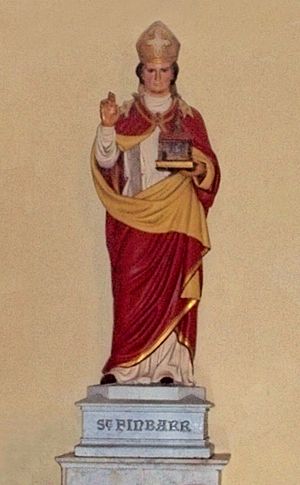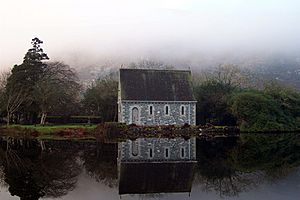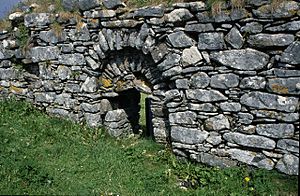Finbar of Cork facts for kids
Quick facts for kids Finbar |
|
|---|---|

19th century Statue in the Cathedral of St Mary and St Anne, Cork City
|
|
| Bishop and Abbot | |
| Born | 550 Templemartin, north of Bandon, |
| Died | 623 Cellnaclona (Cloyne) in Ballineadig |
| Venerated in | Eastern Orthodox Church Roman Catholic Church |
| Major shrine | Gougane Barra, Saint Finbarre's Cathedral (Anglican cathedral, Cork) |
| Feast | 25 September |
| Patronage | Cork, Diocese of Cork |
Saint Finbar (also known as Finbarr, Finnbar, or Finnbarr) was an important Irish saint. In the Irish language, his name is Fionnbharra, often shortened to Barra. He lived a long time ago, from about 550 AD to September 25, 623 AD. Finbar was a bishop and the leader (abbot) of a monastery in what is now the city of Cork, Ireland. He is the patron saint of Cork city and the Diocese of Cork. People celebrate his feast day every year on September 25.
Contents
Finbar's Early Life and Studies
Finbar was born in Templemartin, near a town called Bandon. His first name was Lóchán. His father, Amergin of Maigh Seóla, was a skilled craftsman from Galway.
Finbar went to study in a place called Ossory. This area is now known as County Kilkenny. During his studies, he was given a special haircut called a tonsure. The priest who did this said, "Fair is the crest of Loan." This meant his head looked bright or fair. From then on, Lóchán became known as "Fionnbharra," which means "Fairhead" in Irish.
After finishing his education, Finbar traveled. He went on a pilgrimage to Rome with some other monks. On their way back, they stopped to visit St David in Wales.
Founding Churches and Monasteries
When Finbar returned to Ireland, he lived for a while on an island. This island was in a small lake called Loch Irce. Today, this island is known as Gougane Barra. It is a beautiful and peaceful place.
Finbar is believed to have built several small churches. One of these was in Ballineadig, County Cork. This church was called Cell na Cluaine. Sometimes, this name was confused with another town called Cloyne.
For the last 17 years of his life, Finbar settled in an area known as Corcach Mór na Mumhan. This place is now the modern city of Cork. Many monks and students joined him there.
His settlement became a very important place for learning. People used to say, Ionad Bairre Sgoil na Mumhan, which means "Finbarr's foundation, the School of Munster." This saying is now the motto of University College Cork.
In 606 AD, Finbar founded a church and a monastery. They were built on a limestone cliff above the River Lee. This area is now called Gill Abbey. The church he founded became the main church (cathedral) for his diocese. Today, the building on that spot is Saint Fin Barre's Cathedral, which belongs to the Church of Ireland.
There is also a Catholic church in Cork dedicated to St Finbar. It is often called 'the South Chapel' by local people. This helps to tell it apart from the main Catholic Cathedral, which is called Saint Mary and Saint Anne.
Saint Finbar passed away at Cell na Cluaine. He was returning from a visit to Gougane Barra at the time. He was buried in the cemetery next to his church in Cork.
Finbar's Lasting Legacy
Saint Finbar's influence spread far and wide. Many places and institutions are named after him.
For example, there are at least six St. Finbar's schools in England and Australia. These include schools in Chelsea, Ashgrove, Byron Bay, and Melbourne. There is also a St. Finbarr's school in Lagos, Nigeria. In the United States, there is a St. Finn Barr school and church in San Francisco, California.
The first cathedral of the Diocese of Charleston, South Carolina, was also named after St. Finbar. It is thought that John England, the first bishop of Charleston, named it this way. He was from County Cork and was consecrated a bishop in Saint Fin Barre's Church before going to the United States.
In Coventry, England, a social club called St Finbarr's was popular in the late 1980s. It was a place for people with Irish backgrounds to meet. After the club was taken down in 2006, a new housing area was built. The road there was named Finbarr Close, keeping his memory alive.
Other Saints Named Finbar
It can be a bit confusing, but there were actually five different Irish saints named Finnbarr. Some experts believe that the Saint Finbar from Cork might be the same person as Finnian of Moville. Finnian was a teacher of another famous saint, Colm Cille.
Saint Finbar's name is also found in place names in Scotland. This might be because his followers carried devotion to him there. One such place is the Gaelic-speaking island of Barra. On this island, there is a ruined church called Cille Bharra, which means "Church of Finnbarr." People traditionally believe this Finnbarr is the same saint from Cork. However, some argue that he might have been a Scottish saint.
See also
 In Spanish: Finbar para niños
In Spanish: Finbar para niños




